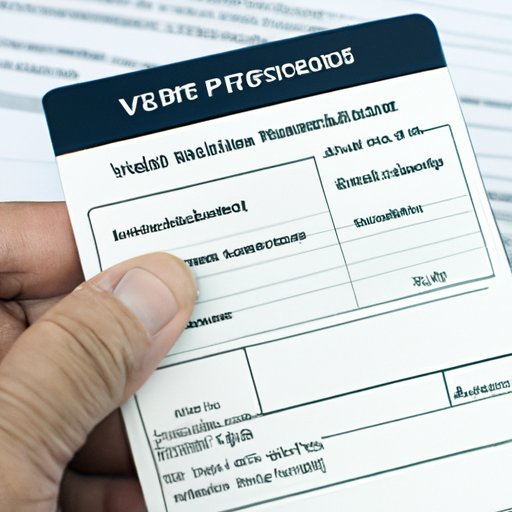
I. Introduction
If you are a veteran, you may be eligible to apply for a Veterans ID card. This is an essential document that will allow you to easily prove your military service and benefit from a wide range of services and benefits offered by the government. The purpose of this article is to provide a step-by-step guide on how to get a Veterans ID card, including eligibility criteria, the application process, and the benefits of having the card.
II. Step-by-Step Guide
The process of getting a Veterans ID card requires fulfilling certain eligibility criteria and submitting an application. Here is a comprehensive guide on how to get a Veterans ID card:
- Gather your necessary documents. To apply for a Veterans ID card, you will need to present your Department of Defense Form DD214, which is a certificate of release or discharge from active duty. If you do not have this document, you can request a copy from the National Archives.
- Check your eligibility. To be eligible for a Veterans ID card, you must have served in the military, be honorably discharged, and have an active-duty service of 24 months or more. If you do not meet these criteria, you may still be eligible for the card if you were discharged due to a service-connected disability or were in the Reserves or National Guard for at least 20 years.
- Submit an application. You can apply for a Veterans ID card online through the Department of Veterans Affairs (VA) or visit your nearest VA regional office. Be sure to include all necessary documents as part of your application.
- Wait for your application to be processed. Generally, it takes four to six weeks for an application for a Veterans ID card to be processed. You can check the status of your application on the VA website.
By following these steps, you can get a Veterans ID card and enjoy its benefits.
III. Eligibility Requirements Explained
The following veterans are eligible to apply for a Veterans ID card:
- Veterans who have honorably served in the military for at least two years.
- Veterans who were discharged due to a service-connected disability.
- Retirees who served in the Reserves or National Guard for at least 20 years.
- Former military personnel who are receiving VA compensation for a service-connected disability.
In addition to these eligibility criteria, you must submit your DD214 form or a comparable alternative, such as a Statement of Service or Certificate of Release.
IV. How to Appeal a Denied Application
If your application for a Veterans ID card is denied, you have the right to appeal the decision. Here are some tips for contesting a denial:
- Review the reason for the denial carefully.
- Provide any additional documentation that may further prove your eligibility
- If possible, speak with somebody at the VA who can help address any questions or issues with your application.
If your appeal is unsuccessful, you can still apply for a Veterans ID card later, once you can meet all eligibility criteria.
V. The Benefits of a Veterans ID Card
A Veterans ID card offers numerous privileges and benefits, including:
- Access to VA medical facilities and services
- Discounts at various retailers and restaurants
- No-cost flu shots and health screenings
- Proof of veteran status, which can be used to secure other benefits and services
- Honored at businesses that participate in the VA’s Veterans Identification Card Benefits program.
Since benefits may vary for each individual, it is best to check with the VA or provider of the specific service or benefit to see what they offer for veterans.
VI. Frequently Asked Questions
Here are some of the most commonly asked questions about Veterans ID cards:
- How much does the Veterans ID card cost?
The Veterans ID card is free.
- Where can I apply for a Veterans ID card?
You can apply on the VA website or at your nearest VA regional office.
- How long does it take to get a Veterans ID card?
Generally, it takes four to six weeks for an application to be processed.
VII. How to Replace a Lost or Stolen Card
If you lose your Veterans ID card or it gets stolen, you can request a replacement by contacting your local VA office. For identification purposes, you will need to provide a valid government-issued photo ID and proof of your military service. Additional documentation may also be requested.
To prevent losing your card in the future, you may want to consider making a copy of your card, keeping it in a safe place, and only bringing your ID card with you when you need it for specific benefits.
VIII. Conclusion
Getting a Veterans ID card is a straightforward process when you know the steps. By following the requirements and application guidelines, veterans can enjoy numerous benefits that come with holding a Veterans ID card. We hope that this article provides you with helpful information and resources to successfully obtain your very own Veterans ID card.
For more information on Veterans ID cards and other services and benefits for veterans, make sure to check out the VA website and other resources available.





